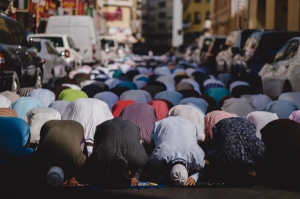Recent PhD student Lamiae Aidi offers this blog post (the second in a series) on Islamophobia in popular culture as a knowledge mobilization component of her successful degree, recently completed under the supervision of Vivek Venkatesh. Click here to read part 1 in the series.
notice
Non-Movements, Transnationalism and Popular Culture
 Photo by Levi Meir Clancy on Unsplash
Photo by Levi Meir Clancy on Unsplash
Soon after the Arab Spring, scholar Hamid Dabashi made the argument that the effects of the Arab Spring can be seen abroad (where there are other forms of oppression), in the form of anti-imperial and anti-capitalist movements such as the Wall Street movement (Dabashi 2013). This post-Arab Spring anti-colonial sentiment in the diaspora described by Dabashi is also seen in the form of a non-movement manifesting itself through the massive consumption of cultural objects by Muslim artists contesting stereotypes. Non-movements are trends and practices (including sayings) of millions of individuals with similar problems. While social non-movements are not planned, they represent the people because solidarities are formed in spaces of flow and movement through individual yet similar complaints about communities (Bayat 2013). The world-wide popularity of the cultural objects produced by the ‘Other’ him or herself is, in my opinion, reflective of a non-movement by audiences engaged in the acts of circulating and consuming the material, not because they planned it, but because it speaks to them. The popular culture produced is serving as fast and easily accessible exchange of contextual realities; and the on-line availability of popular culture facilitates circulation.
In addition, from the lens of film critic Evelyn Alsultany's theory on transnationalism, that circulation and translation of narratives across national borders and diasporas offers audiences new transnational perspectives which then create new space for cultural dialogue: transnationalism opens up room for new cultural dialogues on diasporic identities and resistancies and includes analysis of contemporary representation in actual geographical locations and diasporas as well as in the digital world. The digital era has enabled and accelerated this exchange of cultural objects across countries and diasporas. Circulation and translation of narratives across national borders and diasporas offers audiences new transnational perspectives which then create new space for cultural dialogue. Exchange of digital popular culture is exchange of contextual realities across countries and diasporas, some of which serves to contest and break down stereotypes, or at least present newer and more diversified images of Arabs and Muslims. Digital everydayness increases this cultural dialogue by facilitating wider understandings of marginalized identities by majority communities.
One such example of a narrative examined by Alsultany is Brazilian Telenovela El Clon, (The Clone), which follows the life of a Moroccan family living in Brazil and aired worldwide from 2002 to 2010. El Clon, which is originally in Portuguese, was dubbed into Spanish for a Latin American audience, and subsequently into Turkish, Hebrew, and Russian. The Telenovela was criticized for its Orientalist imagery similar to that found in European and North American productions, i.e harems, veils, belly dancing, and “fascination with a distant Moorish/Iberian past” (Alsultany 2013, 13). Yet, the work also encouraged global trends in belly dancing and a new fusion music, called Belly-Samba. El Clone is important because depictions of Muslims in the West are usually generated in Europe and North America. The series hence creates awareness of a Latino-Arab culture rarely portrayed in popular culture.
References
Alsultany, Evelyn, and Ella Shohat. Between the Middle East and the Americas: The Cultural Politics of Diaspora. Ann Arbor: University of Michigan Press, 2013.
Bayat, Asef. Life as Politics: How Ordinary People Change the Middle East. Stanford, CA: Stanford University Press, 2013.
Dabashi, Hamid. Being a Muslim in the World. New York: Palgrave Macmillan US, 2013.